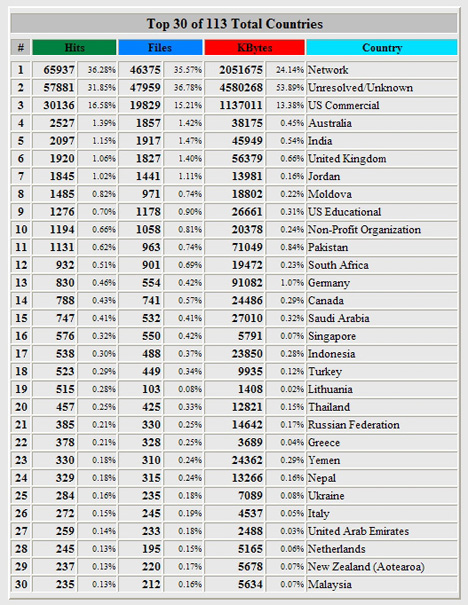| |
April
2013 - Volume 7, Issue 2
Impact
Factor and Indexing
(Compiled: March 7, 2013)
Journals
World Family Medicine / Middle East Journal of Family Medicine
Middle East Journal of Age and Ageing
Middle East Journal of Business
Middle East Journal of Nursing
Middle East Journal of Internal Medicine
Middle East Journal of Psychiatry & Alzheimers
We have had many recent enquiries regarding Impact Factor,
Indexing, DOIs, searching for articles on Google and other
circulation data, so this following report will be issued
on a regular basis and made available within each issue of
the journals.
Indexing, Impact Factor* and Open Access
All journals were indexed on EBSCO databases in July 2011
so we will shortly be able to provide full Impact Factors,
which are based on readership of an article over the previous
3 years and how often it was cited.
The Middle East Journal of Nursing (ME-JN) is listed on Cinahl
and articles are making an impact in that we have had ME-JN
articles in all the 'top 10 read DOI's' over the past 9 months.
This also possibly reflects a dearth of resources for nurses
globally but ME-JN articles are obviously making a big impact.
Journals are also on the new Middle
East database system Al Manhal, which has been set up exclusively
for the Middle East region and will provide a similar reporting
base for Impact Factors.
Currently we have applications in progress for indexing with
ISI (Thomson Reuters), Medline and Pubmed. The approval system
assesses matters like regular issues, production quality,
quality of articles etc over several years prior to making
a decision, but this report will be a regular feature in the
journals so we will provide updates on our progress with these
organisations.
* While I stress that these are not yet 'official figures',
but based on the BMJ's formula for calculating Impact Factor,
from web statistics (unique browsers downloading journal pages),
the following Impact Factors have been calculated:
MEJFM Impact Factor is 10.1275
ME-JIM Impact Factor is 10.0305
ME-JN Impact Factor is 13.635
ME-JAA Impact Factor is 11.695
Once journals were indexed we took down the journal archives
from the website, however some authors have wanted to maintain
'free to air' access to their articles and have them searchable
via Google, especially if their universities do not use EBSCO,
so in April 2013 we will re-instate, in the Archives section
of the websites, a full (searchable) list of papers and their
authors, with a link to the (free) pdfs for downloading. This
will ensure 'open access' while retaining Indexing and Impact
factors.
DOIs
Journal articles are given a unique
DOI (Digital Object Identifier) organised by CrossRef.org,
and used by academic publishers globally, which can track
the use of your paper in various modes, including direct hits
and references to your article from other DOI articles. This
provides a much more detailed and accurate report than previous
methods.
Top 10 DOIs
< Top 10 DOIs is a list/report
of the most popular DOIs that were successfully looked up
and how many times each was looked up on a monthly basis.>
CrossRef.org
See also : Digital Object Identifier
System; www.doi.org/
Top articles in the March 2013 CrossRef report (screen print):
The following journals/articles/authors were among those in
the top 10 DOIs in the March 2013 report which covers the
previous 12 months (we both congratulate and thank our authors
for their quality work):
TOP 10 authors:
MEJIM, June 2011: The incidence
of tuberculous lymphadenitis among Jordanian children at King
Hussein Medical Center
Authors: Hashem E. Aqrabawi, Ahmad Abu- Zaid
ME-JAA July 2011: Prognosis of stroke in young old
and old elderly patients: A Comparative study
Author: Ashraf Shehatah
ME-JN November 2011: Infection with chronic diabetic
wounds (detection, classification and treatment)
Authors: L Almoutaz Alkhier Ahmed; Ali Alsharif; Emad Alsharif
ME-JN September 2011: Pender's Health Promotion Model:
An Integrative Literature Review
Authors: Murad A. Alkhalaileh; Mohamad H. Bani Khaled; Omar
G. Baker; Elaine A. Bond
ME-JN September 2011: Hearing assessment in the newborn
Authors: Muna Kawar; Sufyan Al Ruod
MEJFM June 2011: The efficacy of almonds, pistachios,
and a mixture of both, on some risk factors of cardiovascular
disease
Authors: Khogali, Fathia A M.; Babtean, Abrar M.; Bayahya,
Samah H.; Hakeem, Sara H.; Dahlawi, Banan N.; Alharbi, Abrar
A.
Readership and academic profile
In 2012 we did a Middle East academic and readership survey
contributed to by medical academia of the region. This provides
a more in depth readership profile and you can obtain a free
pdf copy by emailing the publisher (lesleypocock@mediworld.com.au
).
Readership / Webstats

February 2013 MEJFM Webstats (screen print)
Despite archives now being deleted from the free online website
versions of all Middle East medical journals, readership remains
impressively high and the MEJFM remains one of, if not the,
highest read medical journal(s) in the world with circa 350,000
readers per issue.
While our webstats show approximately 77% of our readers cannot
be identified (meaning they are probably individual doctors
on private networks/computers) the top 30 countries out of
the 113 countries reading the MEJFM (see below) show a large
global readership, as well as a large regional readership.
The Middle East is contributing substantially to the world
body of knowledge.
If you compare the country hits with national population statistics,
Jordan and the UAE, for example, are high level readers. Looking
at files and kb usage, many are downloading the full journals
each month.
As publisher I have been so impressed by the standards and
spirit of the region and collectively it seems we have made
a huge global impact. My thanks and best wishes, as well as
those of Chief Editor Dr Abyad, go out to you all.
Lesley Pocock
Publisher
|
 |




